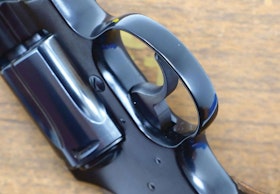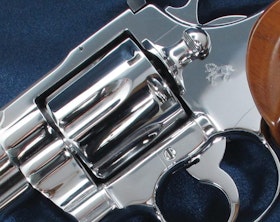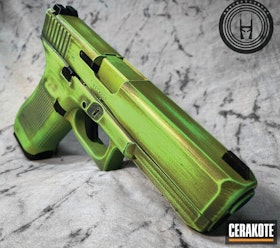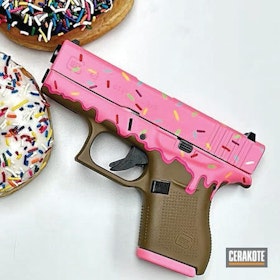There are many ways to finish the surfaces of a firearm, from traditional blued steel to guns coated in elaborate multi-color themes. Explaining the pros and cons of every option can be a challenge, but your customers are looking for answers.
In the firearms industry, terms like “Brunition,” “Tenifer,” and DLC combine and take on the same meaning. We accept that all of them are good. Why would the companies use them and advertise them as benefits otherwise? Products like Ceracoat, Durakote, and KG Gun Kote get grouped similarly so that people get the idea that they are just brands rather than different products. Let's take a look at some of the most popular finishes and hopefully help you explain the differences to your customers.
Blued Finish
Bluing (also known as black oxide) is a chemical process that converts the surface layer of steel into a thin protective layer of oxidation. It’s controlled rusting, but rather than producing iron oxide (red, flaky rust), it produces magnetite – a blackened steel protective coating. There are numerous ways to blue firearms, such as rust bluing, niter bluing, charcoal bluing, etc.. Still, they all follow the basic process of oxidizing the metal surface and turning it into a protective shield against rust. Older hot bluing processes used harsh chemicals and produced a deep blue tint, providing the name for the process. The best examples of how beautiful bluing can be are early Smith & Wesson and Colt revolvers.
Bluing is a classic and timeless finish. It does have drawbacks, though. It is highly susceptible to wear from use. If you look at any used revolver, you’ll instantly see the wear marks where the finish is rubbed away. It can also be removed if the wrong cleaners are used. The blued surface must be protected with oil as an additional moisture barrier.
Stainless Steel
Stainless steel isn’t a finish. It’s a type of steel that includes chromium and nickel. Many people say that stainless steel won’t rust. That’s not true, but it is more rust-resistant. When rust does occur, it’s usually minor surface rust that can easily be cleaned or polished away to restore the surface. In addition to its rust resistance, it is roughly three times stronger than standard steel and doesn’t require the frequent lubrication of a blued finish. Depending on individual preferences, stainless steel can have a blasted, brushed, or highly polished appearance.
Nickel
Nickel finish is a plating process whereby a thin nickel coating is applied for protection and appearance. Nickel plating was an early version of chrome plating and provides the same bright, mirror-like appearance.
Nickel-plated guns are easy to maintain with just basic cleaning and light polishing. However, it is essential to remember that cleaning products containing ammonia will damage the finish. Plating is highly durable but can chip or flake off if abused. Once damaged, the only fix is to have it chemically stripped and re-plated.
Parkerization
Parkerizing is another finish that’s been around since World War I. It’s a chemical dip process that adds a coating of phosphate and other chemicals. The finish is ideal for extreme duty applications like military and police operations. It will endure years of use without changing appearance but is easily re-applied if damaged.
Modern Finish Options
As mentioned in the introduction, technology has allowed the development of improved coatings that are more consistent, need less lubrication, and are much more durable than most other finishes. There are several different names in this category. Let’s look at a few.
Brunition is a baked-on Teflon/polymer finish applied over Parkerization, proven highly durable over decades of military and police use.
Tenifer is Glock’s term for a metal treatment known as Ferric Nitrocarburizing, whereby nitrogen and carbon are infused into the metal under controlled temperatures. The process changes the surface of the metal, making it harder and thus highly resistant to wear. Glock used this treatment until 2010 when it changed to nDLC (more on that shortly).
Ferric Nitrocarburization is not exclusive to Glock. Other manufacturers use the same process under different trade names. Smith & Wesson uses Armornite (previously called Melonite), and Heckler & Koch refer to it as “Harsh Environment.” Though each formulation may vary slightly, the process and results are the same. One note is that metal subjected to Ferric Nitrocarburizing has no added color. Glock used to apply Parkerization to the slide after the treatment to give it a black professional appearance.
DLC (Diamond Like Carbon) is a process that infuses carbon into metal surfaces, making them highly durable. As the name implies, the surface becomes almost as hard as diamonds. It has the added benefit of acting as a lubricant, significantly reducing the need for oil for proper functioning.
Want Color with That?
Gun color choices used to be very limited, reminding me of Carroll Shelby’s comment about his ’65 Mustang GT350s, “You can have it any color you want as long as you want white with blue stripes.”
It wasn’t long before Ford and Shelby caved to popular demand and offered these classic cars in various color schemes. The same thing has happened with guns. Gun stores regularly have gray, pink, purple, and even teal guns. There are dual-finished guns and themed multi-color finishes (think zombies or aliens). It’s no longer a question of what’s available, but what you want.
Spray-on Coatings
There are three oft-mentioned spray-on coatings: Cerakote, Duracoat, and KG Gun Kote. What makes them stand out is the wide variety of colors available and the creative designs they make possible. You’re limited only by your imagination.
Cerakote is a polymer-ceramic coating that provides superior durability and wear resistance. Ceramics aids in the hardness and decreases friction. Properly applied Cerakote is impervious to chemicals and abrasions. Although the thinnest of the three mentioned, it has also been shown to be the toughest. One significant advantage is that the heat-curing process allows the parts to be reassembled and used in hours rather than days. One major disadvantage for Cerakote is that it requires the total disassembly of guns before use. The parts must be cleaned and sandblasted for the Cerakote to adhere correctly. After it is applied, it must be heat-cured in a dedicated, industrial-type oven. Do not do this in a house oven, as the process creates toxic fumes. These can adhere to oven surfaces and remain in the oven afterward.
There are two different formulations: The H Cerakote is mentioned above. It is a two-part process that requires the separate hardener to be mixed before it can be applied and baked — oven-curing limits some applications since many objects can’t endure high temperatures. There are practical size limitations as well. Even if there is a dedicated oven, many rifle parts won't fit inside. The C Cerakote is a pre-mixed formula that can be poured into a spray gun and applied without adding hardeners. It is air-cured rather than heat-cured, making it a more practical formula for most people. Since H Cerakote can’t be stored for re-use, any remaining product must be discarded. This isn’t true with C Cerakote. Any remaining product can be strained into the original container for later use.
One major disadvantage stands out — price. Cerakote is about three times more expensive than its competitors. The argument is whether the Cerakote is worth the added price when its competition offers similar protection for less.
Duracoat is a two-part polymer coating that competes directly with Cerakote. It is applied using the same method as C Cerakote and has similar properties to its competitor. It is air-cured, has more color choices, and is cheaper. The major disadvantage is that the curing time can last four to six weeks rather than a few hours or days. Duracoat is a great alternative for DIY projects and home firearms finishing as long as time is not an issue.
KG Gun Kote is another polymer coating alternative with the same application procedures as C Cerakote and Duracoat. KG Gun Kote is closer to Duracoat, although it has a different formulation and slightly different characteristics.
Firearms finishes have improved year to year. The ones offered today are much more durable than any formerly cited processes. For those carrying a gun daily, the benefits are visible. It is more likely that a customer will inquire about refinishing their weapon due to modifications made than wear. If the slide is cut for an optic, different sights require milling or other custom work is done, these customers will inquire about finish options.
We’ve discussed the bare minimum here. You should research each of these options and expand your knowledge further. Customers view you as the expert. Be prepared.










